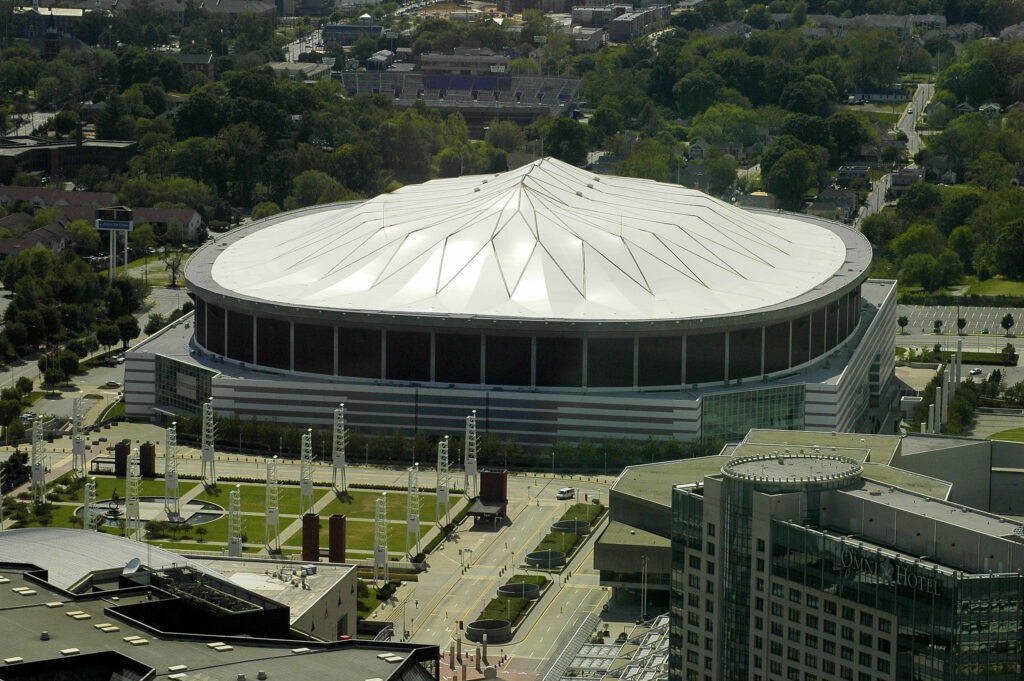The Georgia Dome, a landmark in downtown Atlanta, held a special place in the hearts of sports fans and event-goers. While primarily known as the long-time home of the Atlanta Falcons, this versatile venue, which stood from 1992 to 2017, hosted an incredible range of events, from electrifying Super Bowls to unforgettable Olympic moments and massive concerts. Even though it’s no longer standing, the legacy of the Georgia Dome resonates, especially when considering its successor, the state-of-the-art Mercedes-Benz Stadium, which now occupies the area nearby and continues to host major events in Atlanta.
Beyond serving as the beloved nest for the Atlanta Falcons for many years, the Georgia Dome’s impressive resume included hosting some of the most prestigious sporting events in the world. It was the stage for Super Bowls XXVIII in 1994 and XXXIV in 2000, moments of peak excitement in American football. The global spectacle of the 1996 Olympic Games also utilized the Dome, adding to its international prestige. Basketball fans remember the thrilling 2002 NCAA men’s Final Four and the 2003 NCAA women’s Final Four tournaments that unfolded under its iconic dome roof. Furthermore, it consistently hosted the Southeastern Conference (SEC) and Atlantic Coast Conference men’s basketball tournaments, the intense SEC football championship game, and the national USA Indoor Track and Field championships, solidifying its role as a central hub for diverse athletic competitions.
The story of the Georgia Dome’s creation is rooted in the ambition to keep the Atlanta Falcons in Georgia. In 1988, Rankin Smith Sr., the then-owner of the Falcons and a pivotal figure in bringing professional football to Atlanta and the Southeast in 1965, voiced concerns about the team’s current facilities. Sharing Atlanta–Fulton County Stadium with the Atlanta Braves baseball team for twenty-six years had financial drawbacks for the Falcons, as the Braves retained the majority of revenue from parking and concessions during Falcons games. Smith threatened to relocate the team to Jacksonville, Florida, or another city if a new, dedicated facility wasn’t constructed in Georgia. The Falcons played their final game at Atlanta–Fulton County Stadium in December 1991, setting the stage for a new era.
A crucial agreement was reached in January 1989 between Rankin Smith and then-Georgia Governor Joe Frank Harris. This agreement paved the way for a twenty-year lease for the state-owned Georgia Dome. Groundbreaking commenced on November 22, 1989, marking the beginning of a significant construction project. After more than two and a half years of work, the Georgia Dome was completed at a cost of approximately $210 million. Financing for this massive undertaking was secured through tax-exempt bonds issued by the Georgia World Congress Center Authority, the entity responsible for managing the Dome, along with the Georgia World Congress Center and Centennial Olympic Park. A 2.75 percent hotel/motel tax levied within the city of Atlanta also contributed to the funding.
Upon its grand opening in 1992, the Georgia Dome was celebrated as an engineering marvel, holding the title of the world’s largest rigid cable-supported oval dome. This twenty-seven-story structure was characterized by its distinctive ceiling crafted from Teflon-coated fiberglass. Adding to its architectural grandeur were five-story atriums situated in each of the building’s four corners, creating impressive and spacious interior volumes.
In 2002, Arthur Blank, cofounder of Home Depot, acquired the Atlanta Falcons from the Smith family. Looking ahead, Blank aimed to bring the Super Bowl back to Atlanta in 2009 and proposed substantial interior renovations to the Georgia Dome. However, in 2005, National Football League owners selected Tampa, Florida, to host the 2009 game. The planned large-scale improvements were subsequently cancelled. Despite this setback, around $2 million was invested in 2005 to create the exclusive 250-member Owner’s Club within the dome’s lower level, enhancing the premium fan experience. Blank’s ownership also brought positive changes for general fans; he lowered ticket prices for approximately 23,000 seats, leading to the Falcons’ first sold-out season in over two decades. He also acquired land near the Georgia Dome to establish tailgating areas, fostering a stronger game-day community atmosphere.
The Georgia Dome’s design was generally lauded for its dynamism. However, in August 1995, an incident occurred when heavy rainfall caused water to pool on a section of the roof, leading to a tear in the fabric. Repairs were promptly made, and structural adjustments were implemented to prevent similar issues in the future, ensuring the continued safety and integrity of the iconic dome.
Interestingly, despite its strong association with the Atlanta Falcons, the Georgia Dome actually hosted more basketball games than football games throughout its lifespan. Beyond numerous NCAA basketball events, the Atlanta Hawks called the Georgia Dome home for two seasons while their current venue, then Philips Arena (now State Farm Arena), was under construction. A historic moment for basketball occurred at the Georgia Dome on March 27, 1998, when a National Basketball Association record crowd of 62,046 fans gathered to witness Michael Jordan’s final game in Atlanta as a Chicago Bull against the Hawks. Jordan scored 34 points in a Bulls victory, marking a memorable night in sports history within the Dome.
The period spanning late 2005 and early 2006 was arguably the Georgia Dome’s most intensely busy period. On December 30, 2005, 65,620 spectators watched the Louisiana State University Tigers triumph over the Miami Hurricanes in the Chick-fil-A Bowl. Two days later, 70,796 fans witnessed the Falcons’ season finale against the Carolina Panthers. Then, on January 2, 2006, a remarkable 74,458 attendees saw the West Virginia Mountaineers defeat the Georgia Bulldogs in the Sugar Bowl. The Sugar Bowl’s relocation to Atlanta from New Orleans was due to the devastating impact of Hurricane Katrina in August 2005, highlighting the Georgia Dome’s capacity to accommodate major events even under extraordinary circumstances.
The Georgia Dome also served as a major concert venue, welcoming legendary musical acts such as the Rolling Stones, Paul McCartney, U2, the Backstreet Boys, and Alabama, as well as events like the VIBE Musicfest. Its versatility extended to hosting large-scale trade shows, including Amway conventions, professional wrestling events, and significant religious gatherings led by prominent figures like Billy Graham and Bishop T. D. Jakes, demonstrating its broad appeal and utility for diverse purposes.
In 2014, the Atlanta Falcons and the City of Atlanta embarked on the construction of the Mercedes-Benz Stadium, situated just south of the Georgia Dome. This new, cutting-edge stadium opened in August 2017. With the arrival of the Mercedes-Benz Stadium, the Georgia Dome’s time came to an end. It was demolished in November 2017, making way for new developments in the area, with the Mercedes-Benz Stadium taking over as the premier venue for major events, including Falcons games and much more.
The final game played by the Falcons in the Georgia Dome took place in January 2017. It was a momentous occasion as they defeated the Green Bay Packers to win the National Football Conference championship, securing their place in the Super Bowl. This victory marked a fitting farewell to an iconic structure that had been central to Atlanta’s sports and entertainment scene for a quarter of a century. While the Georgia Dome is gone, its memory lives on, intertwined with the excitement now surrounding the Mercedes-Benz Stadium and the ongoing legacy of major events in Atlanta.


